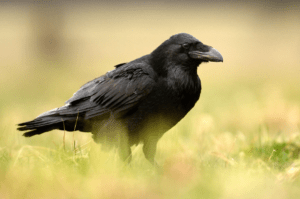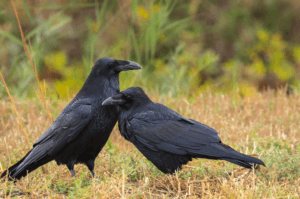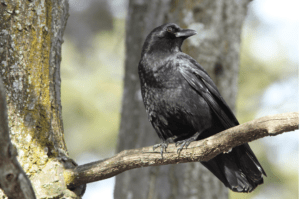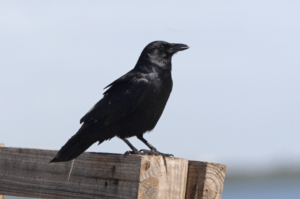Wild crows that reach maturity typically live for around 6–10 years. Crows in captivity may live much longer.
Crows are known for their intelligence, boldness, and adaptability to crowded human-dominated habitats. Do these traits impact a crow’s ability to live a long life?
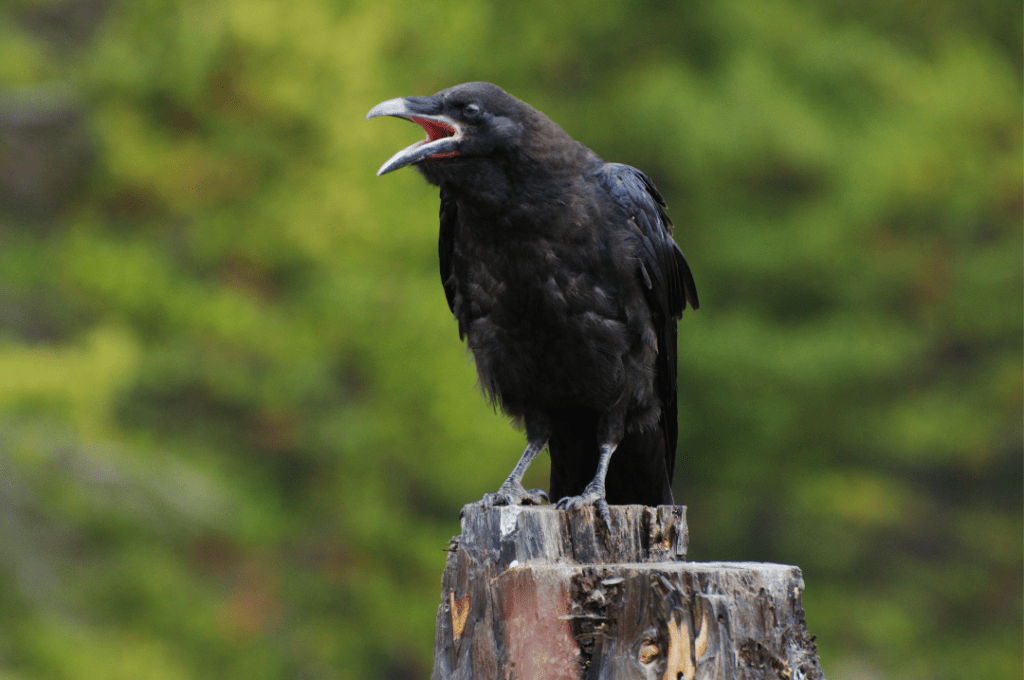
Let’s tackle “how long do crows live?” from every angle. We’ll mix in some facts on their raven cousins, too. Here’s what we’ll cover:
- The life cycle of a crow
- What age can crows and ravens reach in the wild?
- How long can crows and ravens live in captivity?
- Common causes of death for wild crows
The Life Cycle of a Crow
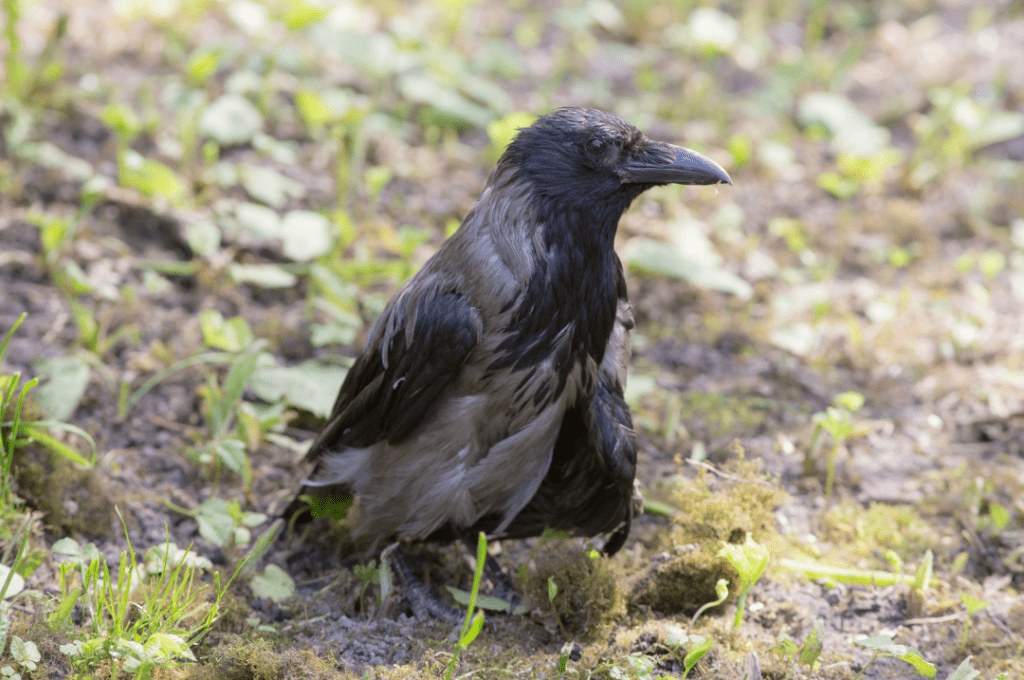
As with most birds, the world is most dangerous during the early phases of a crow’s life. Young crows that haven’t left the nest are vulnerable to predators like owls and raccoons. They can also be thrown from the nest by bad weather or may starve if something happens to their parents.
According to the Cornell Lab of Ornithology, only about 50% of crows survive their first year.
Once a young crow can fly and feed itself, the going gets easier.
A crow’s life cycle proceeds as follows:
- Incubation: clutches of 3–6 eggs are incubated for 16–18 days
- Nestling period: after hatching, chicks stay in the nest for 20–40 days
- Fledgling stage: continued dependence on parents for food may last for several weeks after young crows leave the nest
- Breeding age: first mating occurs after two years of age, usually later
- Adult life: typically 6–10 total years of life for crows that survive the past fledgling stage
Similar to other highly intelligent species throughout the animal kingdom, crows have rich social lives and maintain extended family relationships throughout their lifetimes.
During nesting season (spring and early summer), crows live in small family groups of 2–8 individuals.
Throughout the rest of the year, most crows expand their social networks to enormous proportions, gathering together each night in roosting groups that number many hundreds or thousands of birds.
Crows are physically mature by age two. However, most don’t begin mating before their third or fourth year. Most crows mate for life.
Mature crows that aren’t yet raising their own young often continue living close to their parents. They even help out with feeding and raising their younger siblings.
In many bird species, the young quickly leave their birth area once they’re able to fend for themselves. They’re often chased away by their parents. Crow parents don’t do this.
Crow family bonds are strong and enduring.
During long-term crow research, ornithologist Kevin J. McGowan observed the return of a two-year-old individual that had been away from its family for over a year. The crow stopped by its old area one day, was welcomed by its family, and spent the day hanging around foraging with them. The next day it left again, making the visit seem very much like a college-age human dropping in on his parents during a long weekend.
What Age Can Crows and Ravens Reach in the Wild?
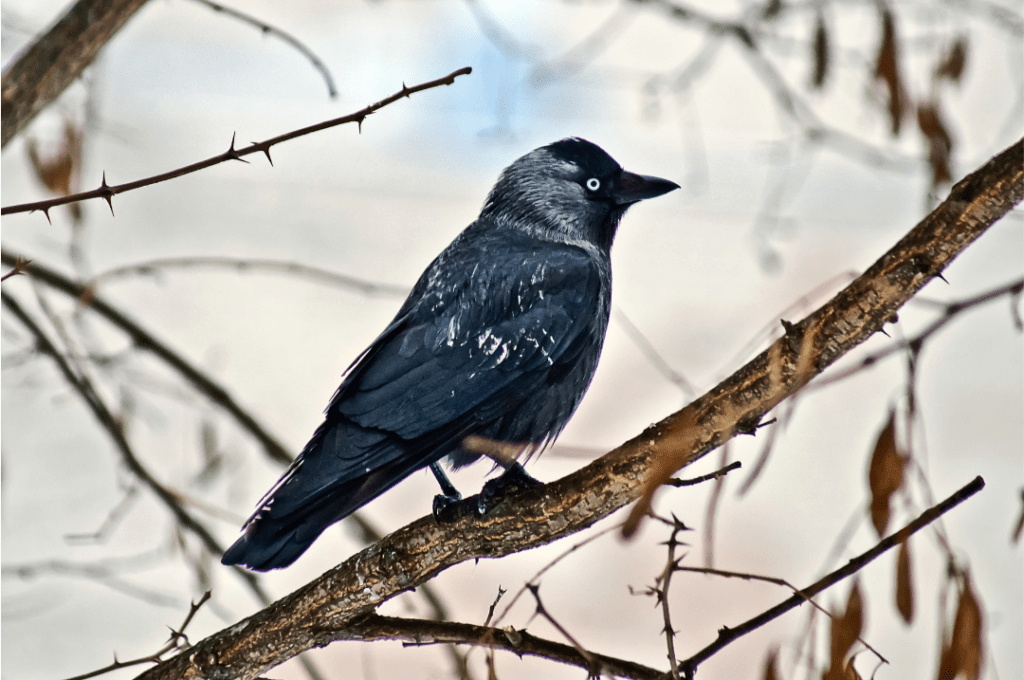
Large birds tend to live longer than small birds. Crows are considered medium-sized. They live longer on average than small songbirds such as sparrows but not as long as larger birds such as eagles.
While the wild crow lifespan is typically described as 6–10 years, average lifespan estimates for wild animals are very rough.
It’s not easy to track enough members of a species from birth to death to generate a robust data set. It’s also difficult to account for infant mortality rates or for the vastly different lives led by members of the same species from region to region.
One of the best ways to understand the lifespans of different bird species is through longevity records, i.e. the longest recorded lifetime of an individual member of a species.
Much of what we know about avian longevity is thanks to widespread bird banding efforts by researchers over many decades.
Banding involves attaching a tag with an ID number to a bird’s leg. When the bird is recaptured at a later date, its entry in the United States Geological Survey (USGS) Bird Banding Lab database can be updated.
When a banded bird is recaptured and proven to be older than any previous documented member of its species, the Bird Banding Lab updates its longevity record list.
Here are the longevity records for each crow species found in the US, along with the records held by their close relatives, ravens.
Crow or Raven Species | Longevity Record |
Common raven
| 22 years, 7 months |
Chihuahuan raven
| 21 years, 9 months |
American crow
| 17 years, 5 months |
Fish crow
| 13 years, 9 months |
Data source: USGS Bird Banding Lab
Crows and ravens are very similar species, both belonging to the Corvidae family. Ravens are larger and tend to live longer (estimated average lifespan of 10–15 years).
How Long Can Crows and Ravens Live in Captivity?
It’s illegal to keep crows and other wild birds as pets. However, it’s not uncommon for crows to end up in captivity.
Because crows are so abundant and widespread in urban and suburban environments, injured crows are often brought to wildlife rehab centers.
If a crow survives an injury but is left with a handicap, such as an inability to fly, then it may end up living out the rest of its days under the care of a rehab staff. Sometimes, this results in lifetimes that last much longer than typically occur in the wild.
Crows and other birds living in captivity have several longevity advantages, including:
- No risk of predation
- Protection from extreme weather
- Access to a healthy diet with no risk of starvation
- Veterinary care for injuries and illnesses
The oldest known crow in captivity was Tata, of Bearsville, New York. Tata lived an estimated 59 years from 1947 to 2006. Another famously old individual named Edgar Allan Crow died at age 25 in 2020 in the Saginaw Children’s Zoo in Michigan.
Captive ravens are able to live even longer than crows. The oldest documented age for a raven in captivity was 69 years.
Common Causes of Death for Wild Crows
Crows are clever enough to get themselves into and out of all sorts of trouble. However, it’s always tough to live a long life in the wild.
Common causes of death for wild crows include:
- Disease
- Motor vehicle collisions
- Predation by cats, hawks, or other predators
- Human hunters (crows are a regulated game animal and can also be killed without a permit in some places to protect crops or livestock)
Crows and ravens are considered highly vulnerable to avian diseases. These include avian poxvirus, hemoparasites, and the West Nile Virus.
In particular, the West Nile Virus is known as a major crow killer. Crows catch the disease from mosquitoes or by feeding on the carcasses of infected dead birds.
Appreciating the Fascinating World of Crows
Longevity is just one of the many remarkable traits of crows.
Wild crows are endlessly interesting to observe, with their playful, clever, and highly social natures on constant display.
If you’d like more up-close looks at your local crows, check out our guide on how to attract crows to your yard.

Kelly is an environmental science writer, naturalist, and birdwatcher. Kelly holds a master’s degree in environmental policy and has worked as an environmental analyst, urban planner, and professor of environmental planning.

